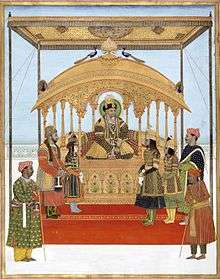Mirza Jahangir
| Mirza Jahangir | |||||
|---|---|---|---|---|---|
| Prince (Shahzada) of the Mughal Empire | |||||
| Born |
1791 Red Fort, Delhi | ||||
| Died |
18 July 1821 , Allahabad | ||||
| Burial | Nizamuddin Dargah | ||||
| Wives |
| ||||
| Issue | Sulaiman Jah, Siphr ud-Daula, Zafar Yab Jang (son), Nawab Asa Ra'afat Sultan Begum Sahiba (daughter) and Nawab Quraisha Sultan Begum Sahiba (daughter) | ||||
| |||||
| Dynasty | House of Timur | ||||
| Father | Emperor Akbar Shah II | ||||
| Mother | Mumtaz Mahal | ||||

Shahzada Mirza Muhammad Jahangir Bakht Bahadur (also known as Prince Mirza Jahangir Bakht) (1791– 18 July 1821[1]) was the son of Prince Mirza Akbar, who became the Emperor Akbar Shah II in 1807 and his wife Empress Mumtaz Mahal, he was also the younger brother of Emperor Bahadur Shah II and older brother of Mirza Jahan Shah.[1] Under the pressure of his mother, Mumtaz Begum, Akbar Shah declared him as his successor. However, after he attacked the British resident, Archibald Seton, in the Red Fort, the East India Company exiled him and eventually Bahadur Shah II succeed his father 1837, to become the last Mughal ruler of India .[2] He was Subehdar of Assam from 1813-1818.he was the 32 mughal ruler in Assam.
Biography
Mirza Jahagir's father, the Mughal Emperor Akbar Shah II (r. 1808 -1837) was not happy with his eldest son Siraj Uddin “Zafar” (Bahadur Shah Zafar II) and wanted to nominate his younger son Mirza Jahangir as the heir Apparent (Wali-Ahad). This move was not liked by the then British Resident in the Red Fort, Sir Archibald Seton. Once Mirza Jahangir who was a reckless youth of 19 insulted Seton in open court and called him Loolu. The British Resident somehow did not react to this insult as probably he did not understand the meaning of Loolu. After a few days, when Mirza Jahangir was merrymaking on the roof of Naubat Khana in Red Fort, Archibald Seton was coming from the Darbar after an audience with Resident. Mirza Jahangir fired a shot at the Resident from the roof of Naubat Khana. Seton escaped but his orderly was killed. For this act of his, Mirza Jahangir was exiled to Allahabad under orders of the British Resident.[3][4]
The mother of Mirza Jahangir Queen Mumtaz Mahal Begum, was distraught and took a vow that if her son was released from Allahabad she would offer a chadar of flowers at the dargah of Khwaja Bakhtiar ‘Kaki’ at Mehrauli. After a couple of years Mirza Jahangir was released and like a devout lady Mumtaz Mahal Begum went to Mehrauli to redeem her vow. With her the Imperial Court also shifted to Mehrauli and so did the entire population of Delhi. For 7 days all sorts of merrymaking continued at Mehrauli with Jhoolas (swings) in the mango groves, cock fighting and bull bailin, kites flying, wrestling and swimming bouts. Amidst all this merrymaking with great pomp and show, a chadar made of flowers was offered at the Dargah of Khwaja Bakhtiar Kaki. The Mughal king was secular minded and under his orders floral offering in the shape of a floral pankha was offered at the famous Yogmaya Temple which is also in Mehrauli.
Seeing the response of the people and sensing the enthusiasm generated, it was decided that the festival will be held annually after the rains and people of all communities will offer pankha and chadar at the Dargah of Khwaja Bakhtiar Kaki and pankha and floral offering at Yogmayaji temple. The Darbar was also shifted to Mehrauli for the 7 days of the Festival. The Festival reached its pinnacle during the reign of Siraj-U-ddin “Zafar”, the last Mughal emperor also known as Bahadur Shah “Zafar”. Bahadur Shah “Zafar” went to celebrate “Phool Walon Ki Sair” even in 1857 when Delhi was under siege of the British. This was the last “Phool Waalon Ki Sair” under the Mughals.[5][6][7]
References
- 1 2 "delhi19". Royalark.net. Retrieved 2014-02-14.
- ↑ Husain, MS (2006) Bahadur Shah Zafar; And the War of 1857 in Delhi, Aakar Books, Delhi, P87-88.
- ↑ Say it with Flowers: Phoolwalon-ki-sair Times of India, November 2, 2006.
- ↑ Phool Walon Ki Sair begins Times of India, September 26, 2005.
- ↑ "Mehrauli Bomb Blast And Phool Walon Ki Sair | Indian Muslims". Indianmuslims.in. 2008-09-29. Retrieved 2014-02-14.
- ↑
- ↑ https://web.archive.org/web/20120218104532/http://www.ajourneytoindia.com/delhi-tourism/fairs-and-festivals-of-delhi/phool-walon-ki-sair.html. Archived from the original on February 18, 2012. Retrieved August 18, 2012. Missing or empty
|title=(help)